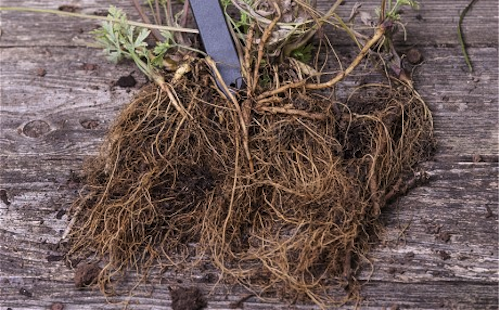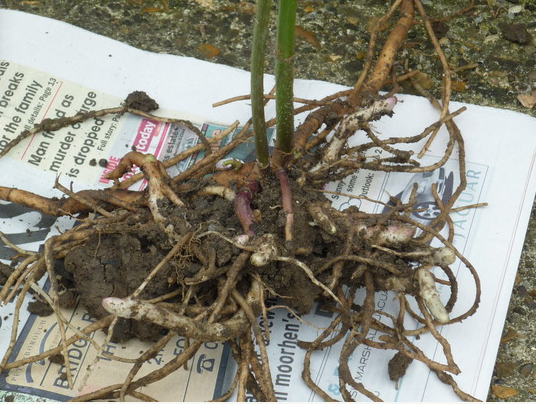Did you know that an examination of the roots of perennial plants can indicate their environmental preferences and how they will behave in your chosen site?Here’s a very interesting portion of an article by Toby Buckland of the UK’s Telegraph that discusses root structure/function:
What roots tell you
Bare-root perennials are exactly that – plants dispatched with bare roots, no compost or plastic pots. This makes them eco-friendly and more economical. Other advantages are that you get a larger clump and, because roots are in immediate contact with the soil, they establish fast. In the same way that smart shoes tell you something about the wearer, roots reveal clues to plants’ preferences.
• Long, elegant tap-roots (pic 1) speak of drought tolerance and an ability to sustain an existence where others fail. Thanks to carrot-shaped roots that draw moisture from deep down, sun-loving sea holly (Eryngium) prospers in rubble-filled soil. A taprooter for shade, Anthriscus sylvestris ‘Ravenswing’ is able to prospect for water among the roots of trees. It will happily grow in ordinary soil, too, but the rule of thumb in tricky ground is keep tap-rooters watered through their first spring to help them establish. That, or start with seed or small plants.
• Brittle fleshy roots (pic 2), such as Dicentra ‘Bacchanal’ and lily of the valley, are a sure sign that the plants love “organic” soil, rich in easy-to-root humus. Fork leafmould into the soil and top up with an annual mulch.
• Clump-formers with a shock of fibrous roots (pic 3) (ornamental grasses such as Miscanthus sinensis ‘Ferner Osten’ and prairie perennials, such as Rudbeckia deamii and asters) thrive in ordinary garden soils at least as deep as your spade blade. The volume and spread of the roots makes for an easy, self-sufficient nature, mitigating against periods of neglect or drought. When planting, fork half a bucket of garden compost into the hole and surrounding soil to encourage roots to spread. Follow up with a mulch.
• The tougher the root, the more robust the plant. Spreading roots as thick as armoured-wire cable (Helianthus ‘Lemon Queen’, and the purple Eupatorium purpureum) are tolerant of a wide range of soils, including spots with only moderate fertility. The roots are rhizomatous, snaking through the soil to find nutrients. Over time they form impenetrable plates just below the surface, hinting at their preference for stony well-drained, mineral-rich ground. If your soil is sticky clay or sits wet in winter, add compost and grit before planting and mound into domes (10cm high/60cm wide) to allow drainage. Tough-rooted flowers don’t need feeding but give them an annual mulch of manure and they’ll be magnificent.
• Fleshy roots, such as those of lysimachia and hosta, reflect a love of moisture-retentive soil. Add a generous bucket of compost when planting to act as a subterranean sponge.
• Flowers with hefty, wrist-thick taproots, such as Russian comfrey and acanthus, are survivors, with the split personality of Jekyll and Hyde. Given a poor soil or spot where the going is tough (in the lee of the hedge or by the compost heap), they pleasantly thrive. Fall out with them and they are monsters to remove – growing back to haunt you if the tiniest piece is left in the ground. Planning as opposed to care when planting is therefore the key.
• Wiry tangles of root topped with chunky above-ground stems reveal a robust nature. The fleshiness of the buds (seen in the more vigorous cranesbills, along with heuchera) provides reserves to thrive in shady/dry spots and shallow soils.
For additional good advice in his article:






